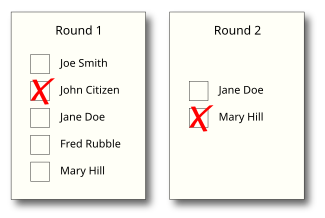Two-round system: Difference between revisions
No edit summary |
No edit summary |
||
| Line 1: | Line 1: | ||
The '''two-round''' system (also known as the second ballot , runoff voting or ballotage or rerun) is a voting system used to elect a single winner where the | [[Image:TRS ballot papers.svg|thumb|325px|right|An example of Tow-round voting system. Re-run voting involves two rounds of voting. Only two candidates survive to the second round.]] | ||
voter casts a single vote for their chosen candidate. However, if no | The '''two-round''' system (also known as the second ballot , runoff voting or ballotage or rerun) is a voting system used to elect a single winner where the voter casts a single vote for their chosen candidate. However, if no candidate receives the required number of votes (usually an absolute majority or 40–45% with a winning margin of 5–15%), then those candidates having less than a certain proportion of the votes, or all but the two candidates receiving the most votes, are eliminated, and a second round of voting is held. | ||
candidate receives the required number of votes (usually an absolute | |||
majority or 40–45% with a winning margin of 5–15%), then those candidates having less than a certain proportion of the votes, or | |||
all but the two candidates receiving the most votes, are eliminated, and a second round of voting is held. | |||
==Terminology== | ==Terminology== | ||
Revision as of 14:28, 10 August 2016
The two-round system (also known as the second ballot , runoff voting or ballotage or rerun) is a voting system used to elect a single winner where the voter casts a single vote for their chosen candidate. However, if no candidate receives the required number of votes (usually an absolute majority or 40–45% with a winning margin of 5–15%), then those candidates having less than a certain proportion of the votes, or all but the two candidates receiving the most votes, are eliminated, and a second round of voting is held.
Terminology
The two-round system is known as a run-off election. Run-off voting is also sometimes used as a generic term to describe any system involving a number of rounds of voting, with eliminations after each round. By this broader definition the two-round system is not the only form of run-off voting, and others include the exhaustive ballot and instant run-off voting (also known as the alternative vote). However the subject of this article is the two-round system.
Voting and counting
In both rounds of an election conducted using runoff voting, the voter simply marks an "X" beside his/her favorite candidate. If no candidate has an absolute majority of votes (i.e. more than half) in the first round, then the two candidates with the most votes proceed to a second round, from which all others are excluded. In the second round, because there are only two candidates, one candidate will achieve an absolute majority. In the second round each voter is entirely free to change the candidate he votes for, even if his preferred candidate has not yet been eliminated but he has merely changed his mind.
Some variants of the two-round system use a different rule for choosing candidates for the second round, and allow more than two candidates to proceed to the second round. Under these systems it is sufficient for a candidate to receive a plurality of votes (i.e. more votes than anyone else) to be elected in the second round.
